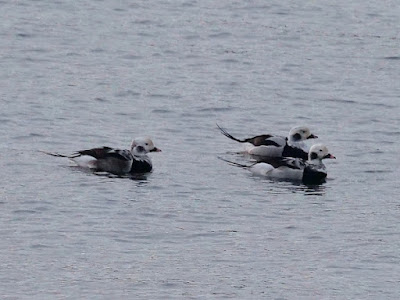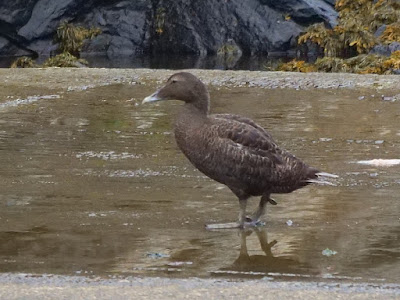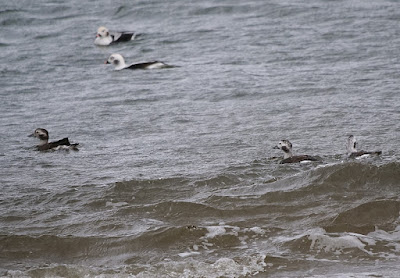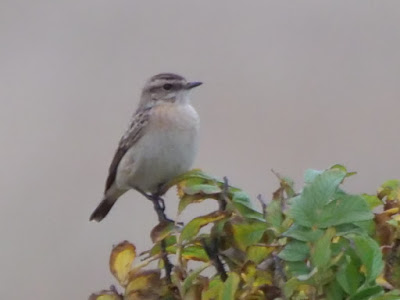Continuing my very enjoyable stay on Unst - personal guiding from Dave and Brenda's wonderful catering made it hard to imagine anywhere I would rather be in October.
Friday 08 October. A calm
morning with light E/SE winds picking up as the day progressed. Feelings of
eastern promise failed to materialize, again. From 07:15 we birded sites around
Norwick, NorthDale, Haroldswick and Baltasound (Clingera and the pines by the school, as it was
finished for the week) with a couple of stops in between.
This included calling in on Brydon Thomasson to collect Brenda’s repaired Svarovski binoculars and return a borrowed pair. I spent the last hour of daylight on Clibberswick
Hill failing to approach a large flock of Golden Plover although at distance they all looked very normal. The day’s highlight
was seeing a very pale juvenile Honey
Buzzard that came in from the direction of Lamba Ness soon after 09:00, passed almost
directly over our heads at Valyie and continued slowly south. My low point was
being behind Dave when he disturbed a Corncrake which dived into cover before I
reached him. Despite searching the area for an hour we failed to see it
again. Also seen were 6 Wigeon, the
2 male Long-tailed Ducks, 400 Golden Plover, 15 Common Snipe, 2 Razorbills,
Great Northern Diver, Grey Heron, 25 Ravens, 3 Chiffchaffs,
13 Blackcaps, 2 presumed blythi Lesser Whitethroats, 2 Goldcrests,
4 Shetland Wrens, 4 Redwings, 2 Robins, Redstart, Whinchat, Dunnock, Tree Pipit, 9 Bramblings and 12 Twite.
 |
| Blackcap at Valyie |
 |
| pale juvenile Honey Buzzard over Valyie |
 |
| this bird initially had us scratching our heads being reminiscent when first seen of both Osprey and Booted Eagle |
 |
| it was seen several times by others as it headed south down the island |
 |
| gliding away on flat wings |
 |
| Brambling at Valyie |
 |
| presumed blythi Lesser Whitethroat at Haroldswick |
 |
| Whinchat at Haroldswick |
 |
| Twite at Millfield |
 |
| Norwick from Clibberswick Hill |
 |
| Song Thrush, not the species I was hoping to see on the dry stone walls of Clibberswick Hill |
Saturday 09 October. We birded
sites around Norwick from 07:20-10:30 seeing very little in very dull and
sometimes drizzly weather. At 11:00 it looked a bit brighter although the wind
had picked up. We went to Skaw which was sheltered in places but again saw very
little other than distant fight views of a presumed out of habitat Barred Warbler. It disappeared over the
brow of a hill, possibly heading towards the cliff edge. We failed to track
it down and with the weather deteriorating we headed back. A few glances out of
the window at Millfield showed no improvement until mid/late afternoon when I walked for an
hour along the coast towards Clibberswick Hill. The black cliffs looked quite
menacing and I kept my distance in the strengthening wind. I flushed a small pale finch-like bird out of the corner of my eye that disappeared over the cliff edge giving the impression of whitish pink, possibly a redpoll. Frustratingly I couldn't refind it without ging closer to the edge than I was comfortable with. We did see the 2 Long-tailed
Ducks, Red-breasted Merganser, Bar-tailed Godwit, 2 Sanderlings, 3 Razorbills, 2 Black
Guillemots, an almost convincing Siberian and 2 Common Chiffchaffs, 8 Blackcaps, 2 Redwings, Wheatear, 20 Brambling, 6 Twite and 8 Siskins.
 |
| Siberianish Chiffchaff at Skaw, sometimes it looked more convincing than others |
 |
| Shetland Wren at Skaw |
 |
| Cliffs of Clibberswick Hill |
 |
| Red-breasted Merganser at Norwick |
Sunday 10 October. Much as
yesterday we birded sites around Norwick from 07:20-10:15 seeing very little in
dull and sometimes wet weather. From 10:45-14:15 we walked around Lamba Ness
finding shelter during the heaviest showers. The showers were getting heavier
and as the wind picked up the intervals between them shortened. In one such
interval we visited Burrafirth, rushing back to the car at the Shore Station.
We drove around Stove and Harroldswick and were back in Norwick about 16:45,
just ahead of a torrential downpour. It soon blew through but any thoughts I
had of a final wander onto Clibberswick Hill were scuppered by the approach of
more dark clouds. During the day we saw a Pink-footed
Goose (Stove) 3 male Long-tailed
Ducks (the two at Norwick and one at Burrafirth), 4 Eider, Red-breasted
Merganser, Sanderlings, 5 Razorbills, a Carrion and 6 Hooded Crows,
25 Ravens, 2 Chiffchaffs, 6 Blackcaps,
Garden Warbler, Redwing, 2 Wheatears, 20
Brambling, 21 Twite, 2 Siskins and 13 Snow Buntings (on Lamba Ness).

 |
| male Long-tailed Ducks off the beach at Norwick |
 |
| Brambling at Valyie |
 |
| Snow Buntings on Lamba Ness |
 |
| Pink-footed Goose at Stove |
Monday 11 October. With NW
winds forecast Dave reckoned there were two options, looking for redpolls or
seawatching. Dave has a considerable fondness for Hornemann’s Arctic Redpolls
having found lots on Unst in recent years, so many he seems to be
singlehandedly doing his best to have them removed from BBRC species list. With
the winds lighter than forecast we went for the former and were out at 07:35
driving down to Norwick beach. Three male Long-tailed
Duck were in the bay but very little was seen on the beach, nearby fields
or at Valyie. Switch to plan B, seawatching, but driving towards Lamba Ness the
weather looked to be improving and we continued on to Skaw in the hope of
redpolls (back on plan A again). We walked out around the headland where a Snow Bunting flew over and Fulmars and Gannets were passing in moderate numbers. With dark clouds approaching
we decided to revert to our seawatch plan and headed to Lamba Ness. Fulmars, Gannets and auks were
passing at a steady rate and it wasn’t long before Dave picked out a Blue Fulmar and Sooty Shearwater. In two hours from 10:45 we saw 2000+ 'normal' and 5 Blue Fulmars, 400+ Gannets, 20 Sooty Shearwaters, 2 Little
Auks (one looked to be in summer plumage), 250+ Razorbill/Guillemots (of which 2/3rds of those identified were the
former), 2 Arctic Terns, a Bonxie and best of all a stunning full
summer-plumaged White-billed Diver
heading north. Also a distant slim small skua flew south which we wished had been
closer. We were joined for the last half hour or so by Tony Davidson and his
two companions although passage was dropping off and most of the interesting
birds had dried up completely. One of his group spotted two tall ‘shark-like’
fins in the water but lost them before anyone could get onto them. A couple of
minutes later I saw them momentarily and from the size, colour and pointedness
wondered if they were Orcas but surely I would have seen some body? They never
reappeared but Ray O’Rielly saw two Orcas at Lamba Ness a couple of hours later
… We returned to Norwick to warm up and, with news of a Hornemann’s Arctic
Redpoll on Foula, set off at 14:00 on our original quest, walking down to Norwick
beach, where a female Long-tailed Duck
had joined the two males. A Lesser
Whitethroat was in the fields and looking in the trees immediately behind the house at Valyie Dave called
‘Hornemann’s in the sycamore’ or words to
that effect. I saw a movement but the bird I was looking at, although quite striking, was brown and heavily streaked so surely not a Hornemann’s. Considerably puzzled, for a few monents until the Hornemann’s Arctic Redpoll
jumped in beside it. What a bird! The original, a Northwestern race
of Common Redpoll, hardly got
another look. The redpolls moved onto
the drying shed and roof of Valyie before shooting off around the house. I
legged it up the hillside to get a signal and put the news out. Dave walked
around the copse without seeing them again so we left. We continued to NorthDale (2 Merlins)
and Burrafirth (Red-throated and distant
Great Northern Divers). Recent days
had been tough but pretty much everything fell into place for us today. Other
birds seen included 5 Eider, 50 Golden Plover, 2 Chiffchaffs, 4 Blackcaps,
5 Redwings, 2 Robins, 2 Wheatears, 17 Bramblings, 3 Twite and a Siskin. Also
2 presumed Harbour Porpoises at Burrafirth. In the evening I went out several
times to look for the aurora. It was a very cold and dark night with virtually
no light pollution but initially almost complete cloud cover. By 23:00 broken
clouds covered about half the sky revealing many stars. On the northern horizon
between the lower layers of cloud was often a paler wash which, at times and
with a vivid imagination, might have been greenish. No shimmering was noted but
any would probably have been due to my shivering. Attempts at photography, with
phone and camera, produced only all place images despite using a range of
shutter speeds on the latter. Rather a disappointment.
 |
| the Norwick Long-tailed Ducks had increased again |
 |
| Shags at Skaw |
 |
| Dave seawatching at Lamba Ness. It sometimes pays to check the foot of a rainbow |
 |
| This superb White-billed Diver was a more than adequate pot of gold (photo: Dave Cooper) |
 |
| Northwestern (Common) and Hornemann's Arctic Redpolls at Valyie |
 |
| no doubt who was the boss |
 |
| Northwestern (Common) Redpoll at Valyie |
 |
| it took me a while to adjust to the redpolls on Shetland. On my last visit (October 2019) there were lots of frosty Mealy Redpolls around and I saw 2 Arctics, one each of Coues's and Hornemann's. This time there were very few Mealys. 'Northwesterns' were the most frequent Common Redpolls seen with a couple of Greenlands for good measure. Northwesterns |
 |
| Hornemann's Arctic Redpoll and ghost House Sparrow at Valyie |
 |
| what a bird, those trousers! |
Tuesday 12 October. We
seawatched at Lamba Ness from 08:10-10:35, the highlight of me was 12 Sooty Shearwaters. Dave also saw 4 Blue
Fulmars and 2 Little Auks which I failed to pick up. The cold was starting to
take effect so we returned to ‘Redpoll mode’ and continued to Skaw but all we
could find was the ‘Siberian’ Chiffchaff. Today it looked a bit more convincing than it had a few days ago but maybe that was down to the light. We
headed to Norwick Beach to meet Matt Eade leading a Naturetrek group. He’d justseen a Hornemann’s Arctic Redpoll,
presumably the one we’d found the previous day at nearby Valyie. We had a flight view of it as it shot off
along the cliffs towards the start of Lamba Ness. We returned to Millfield
where Brenda had found a flock of four redpolls in the garden – three Commons (a juvenile Mealy and two Northwesterns) and, another Hornemann’s
Arctic Redpoll! After spending some time with the redpolls, which
were quite mobile, we drove to Burrafirth and saw 2 Common Redpolls at the Shore Station, one a large brown streaked Greenland type the other a paler less streaked Northwestern which are now the more predominant type occurring on Unst in autumn. Subsequent stops didn’t produce anything further. As well as the birds
mentioned above I saw 6 Eider, 7 Long-tailed Ducks, 4 Sanderling, 150 Kittiwakes, a Bonxie,
500 auks, 2 Red-throated Divers, 5000+ Fulmars,
1000 Gannets, Blackcap, Brambling, 7 Twite and 2 Siskins. While writing up notes in the evening I became violently
ill, hot and shivery and very weak. Apparently I also looked very pale and Dave and Brenda
called a doctor (on an isolated island one takes no chances). Fortunately he
could find nothing fundamentally wrong with me, gave me some tablets for nausea
and thought with rest I’d be back to normal in a day or two. I was to let him
know if I wasn’t. Very impressive service from the local doctor.
 |
| Sooty Shearwater passing Lamba Ness (photo: Dave Cooper) |
 |
| Siberian Chiffchaff at Skaw |
 |
| Hornemann's Arctic Redpoll at Millfield, a different bird with a more extensive peachy hood and a few pencil-thin streaks on the undertail coverts |
 |
| it was also seen at the same time as the Norwick individual |
 |
| with Northwestern Redpoll |
quite a size difference even though the Hornemann's is closer
 |
| Hornemann's back in the garden |
 |
| Eider at Burrafirth |
 |
| Long-tailed Duck at Burrafirth |
 |
| Greenland Redpoll at Burrafirth |
 |
| a much browner bulkier bird than the other Northwestern types we were seeing |
 |
| Northwestern Redpoll at Burrafirth |
 |
| much whiter below |
Wednesday 13 October. I woke
after a reasonable night – thankfully no dashes to the toilet - feeling much
better if rather weak. A very light breakfast had no ill effect and we walked
down to Valyie. Four Long-tailed Ducks
in the bay, 30 Redwings overhead, a Wheatear on the beach and 8 Bramblings in the area but we couldn’t
find either of yesterday’s Hornemann’s Arctic Redpolls. With news of 4 Orcas
heading north out of Haroldswick Bay we headed for Lamba Ness in the hope of
catching them. Just over an hour later Dave picked out one some distance to our
north and I got onto it for a couple of seconds as it dived. Despite intense
scanning we never saw it again. Not the way I’d hoped to see one. Four were
seen in Norwick Bay at about this time and we wrongly assumed that they were
still on their way as it seems very likely they all passed Lamba Ness submerged,
very frustrating. While watching for the Orcas I saw a Bonxie, 2 Puffins and 10
Snow Buntings but hardly any auks and comparatively few Fulmars and Gannets. A Pink-footed Goose
was with the Greylag Geese at Inner
Skaw. We drove to Burrafurth where the Orcas had been seen the previous day to
find we’d missed them by half an hour. Long-tailed
Duck, Black Guillemot and Great Northern Diver were little
compensation. Later the Orcas were seen at Westing, an option we’d considered
but dismissed as being too much of a long shot as they rarely came into the bay there. They had but would hopefully circuit Unst again before I left although on today's performance they may need to do so several times before I get a decent view. At Burrafirth
we flushed a Jack Snipe and saw 5 Twite. In Norwick a Northwestern and Brenda’s Hornemann’s Arctic Redpoll were on a
wall by the road junction and there were 5 Long-tailed
Duck in the bay (4 males and a female). A return visit to Valyie added Chiffchaff a few more Redwings and Bramblings.
 |
| Orange Peel fungi in Quoys Quarry |
 |
| Hornemann's Arctic Redpoll beside the road in Norwick |
 |
| looking very much like the one Brenda found yesterday |
 |
| the accompanying Northwestern Redpoll |
Thursday 14 October. A day of
strong winds, shifting from W to NW as the day progressed with heavy showers
lessening and the temperature dropping. We checked Norwick Beach at 07:50
seeing an Eider and 4 Long-tailed Duck (3 adult males) before
heading to Lamba Ness. There we seawatched from 08:10-10:20 by which time the
cold was taking effect. I saw 2 Bonxies,
2 Sooty Shearwaters, 3000 Fulmars (Dave saw 2 Blue Fulmars), Merlin and Snow Bunting. We tried again from 12:45-14:05 seeing male Long-tailed Duck, Great Northern Diver, Sooty
Shearwater and 8000 Fulmars
(with another Blue Fulmar for Dave). Skaw provided no shelter and just a Shetland Wren (one of three seen today). From 15:15-17:45, with Dave catching
up on paperwork, I walked down to Valyie, up the ravine and back by the old
road. I saw Brenda’s Hornemann’s Arctic
and 2 Northwestern Redpolls in a
Norwick garden, 8 Long-tailed Duck,
including 4 adult males, off the beach. Other sightings during the day included
Jack Snipe, 15 Ravens, 2 Blackcaps, 30 Redwings, a Robin, 20 Chaffinches
and 14 Twite.
 |
| Hornemann's Arctic and Northwestern Redpolls in a garden in Norwick |
 |
| and vice-versa |
 |
| Hornemann's Arctic Redpoll in Norwick |
 |
| Lamba Ness from the top of the old road |
 |
| Norwick and the top of the old road |
 |
| Clibberswick Hill |
Friday 15 October. With the
wind back to NW, and quite strong, we seawatched from Lamba Ness from about
07:50-10:20. Very impressive numbers of Fulmars
were passing. I did several timed counts of 200 and initially it took 75-80
seconds for that many to pass, falling to 55-60 seconds then rising to 95 seconds.
Crude calculations suggested 25,000 flew north (an average of 10,000 per hour).
Amongst them I saw 9 Blue Fulmars
although I missed several others. We also saw 3 Bonxies, a Black Guillemot
and over 100 unidentified auks, a Red-throated
Diver, 11 Sooty Shearwaters, 250
Gannets and 20 Snow Buntings. Very enjoyable, until the cold set in, but we’d
hoped such an Arctic blast might have produced a bit more variety. After
returning for a welcome cup of tea we waked down to Norwick Beach where there
were 7 Long-tailed Duck, a Sanderling and a Razorbill. In strengthening winds Valyie produced a Chiffchaff, 15 Bramblings, both Hornemann’s
Arctic Redpolls together with 2 Northwestern
Redpolls (nice that they’d joined up) and 2 Siskins. After a late lunch, during which time we missed a couple
of heavy showers, we drove to Haroldswick and walked a circuit around the area
seeing 2 Northwestern Redpolls
(possibly those from the Shore Station a few days ago as one looked very good
for a Greenland). A final look at Norwick Beach produced 10 Long-tailed Duck.
 |
| Long-tailed Ducks at Norwick |
 |
| Bramblings at Valyie |
 |
| Hornemann's Arctic Redpoll at Valyie |
 |
| big obvious white birds proving a challenge for my auto focus |
 |
| both Hornemann's Arctic Redpolls at Valyie, playing hard to photograph |
 |
| unsteady hands is probably my excuse here |







































































































No comments:
Post a Comment
Note: only a member of this blog may post a comment.